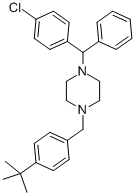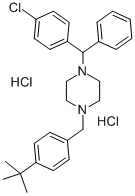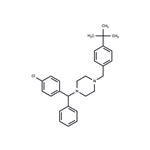
BUCLIZINE
- Product NameBUCLIZINE
- CAS82-95-1
- CBNumberCB9111794
- MFC28H33ClN2
- MW433.03
- EINECS201-448-1
- MDL NumberMFCD00242701
- MOL File82-95-1.mol
Chemical Properties
| Boiling point | bp0.001 217-220° |
| Density | 0.9970 (rough estimate) |
| refractive index | 1.5940 (estimate) |
| pka | 6.84±0.10(Predicted) |
| EWG's Food Scores | 1 |
| FDA UNII | 0C94V6X681 |
| ATC code | R06AE01,R06AE51 |
BUCLIZINE Price
| Product number | Packaging | Price | Product description | Buy |
|---|---|---|---|---|
| Usbiological 443556 | 2.5mg | $602 | Buclizine |
Buy |
| Biosynth Carbosynth FT61369 | 10mg | $775 | Buclizine |
Buy |
| American Custom Chemicals Corporation API0009055 | 1G | $1358.28 | BUCLIZINE 95.00% |
Buy |
| Biosynth Carbosynth FT61369 | 25mg | $1737.5 | Buclizine |
Buy |
| Biosynth Carbosynth FT61369 | 50mg | $3250 | Buclizine |
Buy |
BUCLIZINE Chemical Properties,Usage,Production
Originator
Longifine,UCBUses
Buclizine is an antinauseant.Definition
ChEBI: An N-alkylpiperazine carrying (4-chlorophenyl)(phenyl)methyl and 4-tert-butylbenzyl groups.Manufacturing Process
1 mol 4-chlorobenzhydril chloride was heated in toluene to reflux with 1 mol ethyl ester of piperazine 1-carboxylic acid at about 150°C in a presence of an excess of triethyl amine. On cooling the triethyl amine hydrochloride was filtered off, a solvent was removed in vacuum and the residue [(4-chlorophenyl)- phenyl-methyl]piperazine carboxylic acid ethyl ester was boiled straight away with potassium hydroxide in ethanol for 48 hours. After removing ethanol in vacuum to dryness, the residue was dissolved in benzene and washed with water. The benzene solution was dried, benzene removed in vacuum. The residue was distilled to give 4-chlorobezhydryl-piperazine. It had given the desired 1-(p-tert-butylbenzyl)-4-(p-chloro-α-phenylbenzyl)- piperazine, buclizine, by a reaction with 4-tert-butylbenzyl chloride in the presence of any halogen hydrochloride acceptor (triethyl amine, sodium or potassium carbonate and so on). The obtained product had BP: 230°- 240°C/0.001 mm Hg.brand name
Bucladin (Stuart).Therapeutic Function
Antihistaminic, Antiallergic, Antinauseant, Tranquilizer, Appetite stimulantSynthesis
Buclizine is mainly used in the prevention of motion sickness and in combination with analgesics for treatment of migraine.Preparation Products And Raw materials
BUCLIZINE Supplier
Global(62)Suppliers
| Supplier | Tel | Country | ProdList | Advantage | |
|---|---|---|---|---|---|
| 0917-3909592 13892490616 |
gksales1@gk-bio.com | China | 9311 | 58 | |
| 0592-5800732; +8613806035118 |
xie@china-sinoway.com | China | 988 | 58 | |
| +8613062833949 | fred.wen@crcorporation.cn | China | 8647 | 58 | |
| +86-89586680 +86-13289823923 |
1026@dideu.com | China | 8670 | 58 | |
| +86-0512-83500002 +8615195660023 |
sales@senfeida.com | China | 23046 | 58 | |
| +86-18621343501; +undefined18621343501 |
product@acmec-e.com | China | 33338 | 58 | |
| +1-+1(833)-552-7181 | sales@aladdinsci.com | United States | 52924 | 58 | |
| +8613564774135 | zijue.cai@tsbiochem.com | United States | 19881 | 58 | |
| +8613817748580 | cooperation@kean-chem.com | China | 40066 | 58 | |
| info@syntechem.com | China | 12984 | 57 |
View Lastest Price from BUCLIZINE manufacturers
82-95-1, BUCLIZINERelated Search
PROMPT×
PROMPT
The What'sApp is temporarily not supported in mainland China
The What'sApp is temporarily not supported in mainland China
Cancel
Determine

